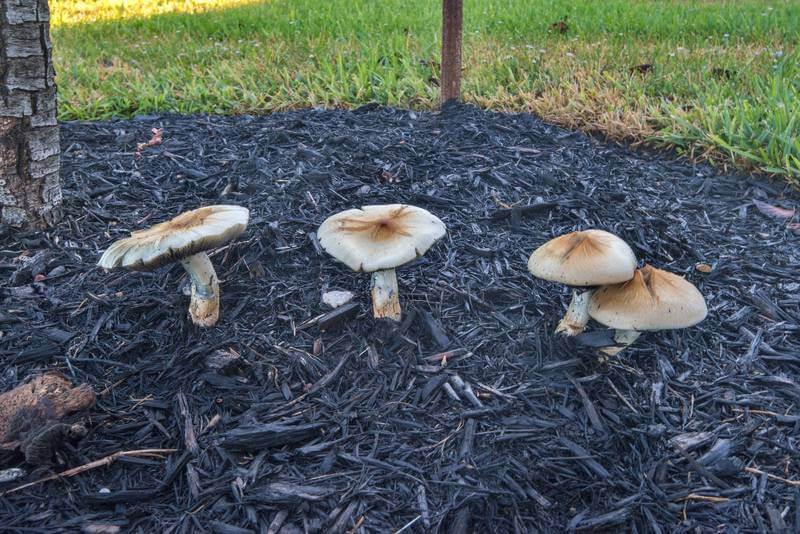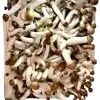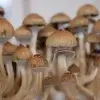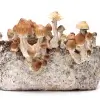Psilocybe cubensis: The Enigmatic ‘Magic Mushroom’ Unveiled
In the vast and mysterious kingdom of fungi, Psilocybe cubensis holds a special place, captivating the minds of psychonauts, scientists, and curious explorers alike. Commonly known as the “magic mushroom,” this unassuming organism has a rich history, intriguing biology, and a cultural significance that spans continents and centuries. Let’s embark on a journey to uncover the fascinating world of Psilocybe cubensis.
A Brief Stroll Through History
Our story begins in the early 20th century when Psilocybe cubensis was first identified in Cuba by American mycologist Franklin Sumner Earle in 1906. The species name “cubensis” aptly reflects its Cuban roots. However, the use of psychoactive mushrooms dates back much further, with indigenous cultures in Mesoamerica incorporating them into spiritual and healing rituals for centuries. These cultures revered the mushrooms as sacred tools, often referring to them as “teonanácatl,” meaning “flesh of the gods.”
Fast forward to the 1950s, when famed ethnobotanist R. Gordon Wasson introduced the Western world to psychedelic mushrooms after his transformative experience with Mazatec shamans in Mexico. By the 1960s, figures like Timothy Leary and Terence McKenna propelled Psilocybe cubensis into the spotlight, solidifying its place in counterculture movements.
Curious how cubensis compares to other potent species? Don’t miss our breakdown of Psilocybe cubensis vs. Psilocybe cyanescens.
The Science Behind the Magic
At first glance, Psilocybe cubensis may appear as just another small, brown mushroom. However, its true allure lies within its chemical composition. The primary psychoactive compounds, psilocybin and psilocin, are responsible for the profound alterations in perception and consciousness experienced by those who consume it.
- Psilocybin: This compound converts into psilocin in the body, which interacts with serotonin receptors in the brain. The result? Enhanced sensory perception, altered thought patterns, and mystical experiences.
- Blue Bruising: The characteristic blue bruising observed when the mushroom is handled is due to the oxidation of psilocin. This bruising has become a hallmark for identifying psychoactive mushrooms.
Recent Neuroplasticity Research
The scientific understanding of how psilocybin affects the brain has advanced significantly in recent years. A groundbreaking 2024 study published in a peer-reviewed journal demonstrated that psilocybin promotes neuroplasticity and induces rapid and sustained antidepressant-like effects in animal models, with these effects accompanied by increased neuroplasticity in the prefrontal cortex and hippocampus (Zhao et al., 2024).
The therapeutic potential of psilocybin has gained substantial scientific recognition, with the FDA granting “breakthrough therapy” designation to psilocybin in 2019 for treatment-resistant depression, acknowledging its potential as a significant improvement over available treatments (Olson & Heifets, 2022).
Recent systematic reviews have found that psychedelics including psilocybin induce molecular and cellular adaptations related to neuroplasticity, which may parallel and potentially underlie their clinical effects in treating depression, anxiety, and addiction (de Vos et al., 2021).
In July 2024, researchers at Washington University in St. Louis used functional magnetic resonance imaging (fMRI) to track changes in brain activity related to psilocybin use, finding that it temporarily disrupts the default mode network—a brain network involved in creating a person’s sense of self—which helps explain the neurobiology of psychedelic experiences (NIH, 2024).
For a deeper dive into how psilocybin rewires the brain, explore our article on How Psilocybin Rewires Your Brain (Without the Trip).
Habitat: Nature’s Hidden Gem
Psilocybe cubensis is a cosmopolitan species, thriving in tropical and subtropical regions across the globe. It has a particular fondness for humid environments and is commonly found in nutrient-rich soils, especially those enriched with dung. This preference has earned it colloquial names like “golden tops” and “cubes.”
- Geographic Distribution: Commonly found in regions like Southeast Asia, Central and South America, Australia, and the southern United States.
- Fungi’s Hitchhikers: Spores of Psilocybe cubensis often hitch a ride on cattle feed or manure, leading to colonies sprouting up wherever the conditions are favorable.
For foragers, spotting these mushrooms in the wild can feel like discovering hidden treasure, but identifying them correctly is crucial to avoid confusing them with toxic lookalikes.
Cultivation: From Spore to Fruiting Body
Cultivating Psilocybe cubensis has become a popular endeavor for both personal exploration and scientific research. The process, while rewarding, requires careful attention to detail. Here’s an overview:
- Spore Inoculation: Using a sterile syringe, spores are introduced into a substrate such as brown rice flour (BRF) or a mixture of manure and straw.
- Colonization: The substrate is incubated in a warm, dark environment where mycelium—the mushroom’s root-like network—begins to colonize.
- Fruiting: Once fully colonized, the substrate is placed in a fruiting chamber with high humidity and indirect light, mimicking the mushroom’s natural environment.
- Harvesting: Mushrooms are carefully harvested when their caps open and the veil breaks, revealing mature spores.
Advancements in cultivation methods, such as the PF Tek technique, have made growing Psilocybe cubensis more accessible to enthusiasts. However, it’s essential to adhere to local laws before attempting cultivation.
New to cultivation? Our beginner-friendly guide on How To Use Spore Syringes and Liquid Culture walks you through the basics.
The Psychedelic Renaissance
In recent years, Psilocybe cubensis has taken center stage in the psychedelic renaissance—a movement dedicated to exploring the therapeutic potential of psychedelics.
Groundbreaking Clinical Research
Clinical research into psilocybin’s therapeutic applications has expanded dramatically. A 2024 study from Emory University demonstrated that psilocybin-assisted therapy could potentially impact more than 5 million people in the United States with Major Depressive Disorder and Treatment-Resistant Depression, pending FDA approval (Emory University, 2024).
Johns Hopkins Medicine continues to lead psychedelic research, with studies showing that psilocybin-assisted therapy, when given with supportive psychotherapy, may provide substantial antidepressant effects that last at least a year for some patients (Johns Hopkins Medicine, 2024).
Current Clinical Applications Under Investigation
The range of conditions being studied for psilocybin treatment has expanded significantly. University of New Mexico Health Sciences researchers are conducting studies to evaluate psilocybin for treating depression, postpartum depression, and depression in patients with life-threatening cancer diagnoses who are experiencing anxiety (University of New Mexico, 2024).
The University of California San Francisco (UCSF) is studying how psilocybin affects people with Parkinson’s Disease and depression, as well as investigating its effects on chronic low back pain and conducting trials on refractory Anorexia Nervosa in young adults (UCSF, 2024).
Government Funding and Research Support
While historically there was limited government funding for psychedelic research, the National Institutes of Health (NIH) has begun supporting studies in this area. In 2024, the National Institute on Drug Abuse (NIDA) committed $1.5 million to fund research advancing psychedelics for treating addiction (NIH, 2024).
The NIH has supported research examining how psilocybin affects brain networks, with findings published in Nature in July 2024 showing that psilocybin causes major changes in functional connectivity throughout the brain, providing important information to inform scientists as they seek to harness the therapeutic potential of psychedelics (NIH Director’s Blog, 2024).
Stay updated on the evolving legal landscape with our article on The Legal Landscape of Psilocybin Mushroom Spores: What You Need to Know.
Varieties and Strains: A Diverse Fungal Family
Psilocybe cubensis exhibits remarkable genetic diversity, resulting in numerous varieties with distinct characteristics. These differences manifest in appearance, growth patterns, and microscopic features. Here are some of the most fascinating varieties available for microscopic research:
- Albino Penis Envy (APE): A remarkable genetic mutation combining the unique shape of Penis Envy with albino characteristics. Under the microscope, APE spores reveal distinctive morphological features and cellular structures that make them particularly interesting for comparative research. Their genetic expression results in specimens with thick, dense stems and reduced pigmentation, creating a visually striking appearance.
- Enigma: One of the most unusual varieties in the fungal kingdom, Enigma displays fascinating coral or brain-like growth patterns rather than the typical cap-and-stem structure. This mutation creates intricate, folded surfaces that are a marvel to observe microscopically. Researchers are particularly interested in studying how this dramatic morphological deviation developed from standard Psilocybe cubensis genetics.
- Jack Frost: This relatively new hybrid strain features striking white caps and stems with distinctive bluish bruising patterns when handled. Under the microscope, Jack Frost spores display unique characteristics and germination patterns, making them excellent specimens for studying fungal genetics and development. Their snow-white appearance makes them particularly interesting for studies on pigmentation in fungi.
- Semperviva (Psilocybe subtropicalis): Unlike the other varieties above, Semperviva represents a different species within the Psilocybe genus. It features unique adaptations to subtropical environments, making its spores and mycelial structures particularly valuable for those studying environmental adaptations in fungi. Comparing its microscopic features with those of P. cubensis varieties offers insights into the evolutionary relationships within the Psilocybe genus.
These varieties are prized by mycology enthusiasts for their unique genetic expressions and the fascinating insights they provide when studied under a microscope. While scientists continue to debate the taxonomic classification of some of these varieties, their distinct characteristics make them valuable specimens for educational research.
Interested in exploring unique strains? Discover the Gandalf Mushroom Strain and its fascinating characteristics.
Fun Facts to Ponder
- Etymology: The name Psilocybe cubensis translates to “bald head from Cuba,” a nod to its smooth cap and place of discovery.
- Global Appeal: Its adaptability has made it one of the most cultivated psychedelic mushrooms in the world.
- Cultural Milestones: The 1970s saw the rise of home cultivation techniques, sparking a DIY revolution in psychedelic exploration.
A Word of Caution
While the allure of Psilocybe cubensis is undeniable, it’s essential to approach it with respect and caution. The legality of possessing, cultivating, or consuming these mushrooms varies by region, and potential users should be fully informed of local laws.
Recent studies have noted increased psilocybin use since policy liberalization began in 2019, with a corresponding rise in calls to poison control centers. Research published in 2024 found links between negative psychedelic experiences and potential health risks, highlighting the importance of clinical supervision and controlled settings for therapeutic use (CNN, 2025).
Researchers strongly caution against self-medicating with psilocybin, as there are serious risks to taking it without supervision by trained mental health experts. Despite promising research, psilocybin is not yet proven or approved as a treatment for any condition (NIH Director’s Blog, 2024).
The psychoactive effects can be profound, and unsupervised use carries risks, especially for individuals with underlying mental health conditions. Proper education, responsible use, and awareness of legal considerations are paramount for those interested in exploring the world of Psilocybe cubensis.
Closing Thoughts
Psilocybe cubensis is more than just a mushroom; it’s a bridge between ancient traditions, modern science, and the mysteries of human consciousness. Its rich history, complex biology, and cultural significance make it a subject worthy of exploration and respect.
As research continues to expand our understanding of this fascinating organism, we find ourselves at the intersection of traditional wisdom and cutting-edge neuroscience. Whether viewed through the lens of mycology, psychology, or anthropology, the story of Psilocybe cubensis offers a fascinating glimpse into the relationship between humans and the natural world—a relationship that continues to evolve as we unlock more secrets of this enigmatic fungus.
Looking to continue your educational journey? Check out our Shop






